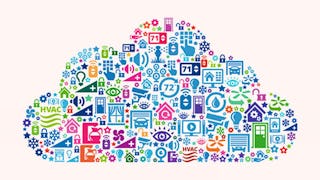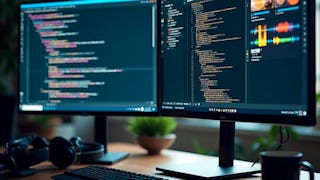Content is an eminent example of the features that contributed to the success of wireless Internet. Mobile platforms such as the Snapdragon™ processor have special hardware and software capabilities to make acquisition, processing and rendering of multimedia content efficient and cost-effective.

Gain next-level skills with Coursera Plus for $199 (regularly $399). Save now.

Internet of Things: Multimedia Technologies
This course is part of Internet of Things and AI Cloud Specialization


Instructors: Harinath Garudadri
25,387 already enrolled
Included with
(307 reviews)
Skills you'll gain
Details to know

Add to your LinkedIn profile
3 assignments
See how employees at top companies are mastering in-demand skills

Build your subject-matter expertise
- Learn new concepts from industry experts
- Gain a foundational understanding of a subject or tool
- Develop job-relevant skills with hands-on projects
- Earn a shareable career certificate

There are 4 modules in this course
Welcome to the Internet of Things! Before diving into this course give us a chance to let you know what it is all about! We will walk you through a module by module outline that will give you highlights on the interesting aspects of the course.
What's included
1 video1 reading
In this course, you will see a lot of new words and acronyms you might not be familiar with. If you feel comfortable with your knowledge of tech terminology, feel free to skip these lessons since they will not affect the overall integrity of the course. If you see something that you want to know a little more about, feel free to watch the video to gain insight on some basic concepts. We do expect you to know the majority of this material before going into the next module, we would recommend going through the lessons as a quick brush up.
What's included
16 videos1 reading1 assignment
In this module our esteemed Professor Harinath Garudadri will talk about coders and decoders (Codecs). This will allow us to make better use of our multimedia choices when working with the DragonBoardTM 410c. We want to look at the motivation behind using Codecs, the different ways to take advantage of redundancies when using codecs and finally the ability to take advantage of different receiver / transmitter combinations. If we are able to understand the way that information is sent and received over the data plane we can create and use the right codecs.
What's included
11 videos1 reading1 assignment
In this module we will talk in depth about computer vision. We will talk about a variety of current applications of computer vision, and brainstorm the future applications you all are capable of making! Ultimately we will set up a computer vision development environment on your Linaro/Debian release capable of creating a wide variety of computer vision projects. By the end of this module we will have built a great basic application in Python, we will add a few features and pass the code on to you! Hopefully this code can serve as a great template for you all to use.
What's included
13 videos2 readings1 assignment
Earn a career certificate
Add this credential to your LinkedIn profile, resume, or CV. Share it on social media and in your performance review.
Instructors

Offered by
Explore more from Electrical Engineering
 Status: Free Trial
Status: Free TrialUniversity of California San Diego
 Status: Free Trial
Status: Free Trial Status: Preview
Status: PreviewBoard Infinity
 Status: Free Trial
Status: Free Trial
Why people choose Coursera for their career




Learner reviews
307 reviews
- 5 stars
76.87%
- 4 stars
16.28%
- 3 stars
3.58%
- 2 stars
1.95%
- 1 star
1.30%
Showing 3 of 307
Reviewed on Aug 7, 2020
The Tutors gave very good introduction to programming in Multimedia. Thanks for the course
Reviewed on Apr 18, 2018
excellent, I like the digital image processing, and the use of different free software tools for it.
Reviewed on Oct 13, 2024
Very helpful for my upcoming college and future jobs

Open new doors with Coursera Plus
Unlimited access to 10,000+ world-class courses, hands-on projects, and job-ready certificate programs - all included in your subscription
Advance your career with an online degree
Earn a degree from world-class universities - 100% online
Join over 3,400 global companies that choose Coursera for Business
Upskill your employees to excel in the digital economy
Frequently asked questions
To access the course materials, assignments and to earn a Certificate, you will need to purchase the Certificate experience when you enroll in a course. You can try a Free Trial instead, or apply for Financial Aid. The course may offer 'Full Course, No Certificate' instead. This option lets you see all course materials, submit required assessments, and get a final grade. This also means that you will not be able to purchase a Certificate experience.
When you enroll in the course, you get access to all of the courses in the Specialization, and you earn a certificate when you complete the work. Your electronic Certificate will be added to your Accomplishments page - from there, you can print your Certificate or add it to your LinkedIn profile.
Yes. In select learning programs, you can apply for financial aid or a scholarship if you can’t afford the enrollment fee. If fin aid or scholarship is available for your learning program selection, you’ll find a link to apply on the description page.
More questions
Financial aid available,

